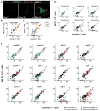Genetic regulators of a pluripotent adult stem cell system in planarians identified by RNAi and clonal analysis
- PMID: 22385657
- PMCID: PMC3338251
- DOI: 10.1016/j.stem.2012.01.016
Genetic regulators of a pluripotent adult stem cell system in planarians identified by RNAi and clonal analysis
Abstract
Pluripotency is a central, well-studied feature of embryonic development, but the role of pluripotent cell regulation in somatic tissue regeneration remains poorly understood. In planarians, regeneration of entire animals from tissue fragments is promoted by the activity of adult pluripotent stem cells (cNeoblasts). We utilized transcriptional profiling to identify planarian genes expressed in adult proliferating, regenerative cells (neoblasts). We also developed quantitative clonal analysis methods for expansion and differentiation of cNeoblast descendants that, together with RNAi, revealed gene roles in stem cell biology. Genes encoding two zinc finger proteins, Vasa, a LIM domain protein, Sox and Jun-like transcription factors, two candidate RNA-binding proteins, a Setd8-like protein, and PRC2 (Polycomb) were required for proliferative expansion and/or differentiation of cNeoblast-derived clones. These findings suggest that planarian stem cells utilize molecular mechanisms found in germ cells and other pluripotent cell types and identify genetic regulators of the planarian stem cell system.
Copyright © 2012 Elsevier Inc. All rights reserved.
Figures







Comment in
-
The planarian Prometheus, quantified.Nat Methods. 2012 May;9(5):432-3. doi: 10.1038/nmeth.2005. Nat Methods. 2012. PMID: 22803200 No abstract available.
Similar articles
-
Clonogenic neoblasts are pluripotent adult stem cells that underlie planarian regeneration.Science. 2011 May 13;332(6031):811-6. doi: 10.1126/science.1203983. Science. 2011. PMID: 21566185 Free PMC article.
-
Cellular and molecular dissection of pluripotent adult somatic stem cells in planarians.Dev Growth Differ. 2010 Jan;52(1):27-41. doi: 10.1111/j.1440-169X.2009.01155.x. Dev Growth Differ. 2010. PMID: 20078652 Review.
-
Different requirements for conserved post-transcriptional regulators in planarian regeneration and stem cell maintenance.Dev Biol. 2010 May 15;341(2):429-43. doi: 10.1016/j.ydbio.2010.02.037. Epub 2010 Mar 15. Dev Biol. 2010. PMID: 20230812
-
Heterogeneity of chromatoid bodies in adult pluripotent stem cells of planarian Dugesia japonica.Dev Growth Differ. 2016 Feb;58(2):225-37. doi: 10.1111/dgd.12268. Epub 2016 Feb 9. Dev Growth Differ. 2016. PMID: 26857694
-
Decoding Stem Cells: An Overview on Planarian Stem Cell Heterogeneity and Lineage Progression.Biomolecules. 2021 Oct 17;11(10):1532. doi: 10.3390/biom11101532. Biomolecules. 2021. PMID: 34680165 Free PMC article. Review.
Cited by
-
Heterochromatin protein 1 promotes self-renewal and triggers regenerative proliferation in adult stem cells.J Cell Biol. 2013 Apr 29;201(3):409-25. doi: 10.1083/jcb.201207172. J Cell Biol. 2013. PMID: 23629965 Free PMC article.
-
Mitochondrial state determines functionally divergent stem cell population in planaria.Stem Cell Reports. 2021 May 11;16(5):1302-1316. doi: 10.1016/j.stemcr.2021.03.022. Epub 2021 Apr 15. Stem Cell Reports. 2021. PMID: 33861990 Free PMC article.
-
The planarian Prometheus, quantified.Nat Methods. 2012 May;9(5):432-3. doi: 10.1038/nmeth.2005. Nat Methods. 2012. PMID: 22803200 No abstract available.
-
Schistosoma mansoni Fibroblast Growth Factor Receptor A Orchestrates Multiple Functions in Schistosome Biology and in the Host-Parasite Interplay.Front Immunol. 2022 Jun 22;13:868077. doi: 10.3389/fimmu.2022.868077. eCollection 2022. Front Immunol. 2022. PMID: 35812433 Free PMC article.
-
Cell type transcriptome atlas for the planarian Schmidtea mediterranea.Science. 2018 May 25;360(6391):eaaq1736. doi: 10.1126/science.aaq1736. Epub 2018 Apr 19. Science. 2018. PMID: 29674431 Free PMC article.
References
-
- Bardeen C, Baetjer F. The inhibitive action of the Roentgen rays on regeneration in planarians. J Exp Zool. 1904;1:191–195.
-
- Boyer L, Plath K, Zeitlinger J, Brambrink T, Medeiros L, Lee T, Levine S, Wernig M, Tajonar A, Ray M, et al. Polycomb complexes repress developmental regulators in murine embryonic stem cells. Nature. 2006;441:349–353. - PubMed
Publication types
MeSH terms
Grants and funding
LinkOut - more resources
Full Text Sources
Miscellaneous

